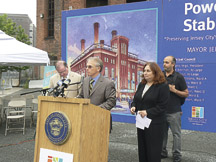The Powerhouse doesn’t only refer to the old railroad power station in downtown Jersey City that has sat abandoned and deteriorating for 80 years. It also refers to a proposed “arts district” of the same name. Approved in November 2004, the original plan for the district has slowly fallen by the wayside due to encroaching development and because city officials seem to have abandoned their original goal.
Opposing forces continued to debate the future of the district this month.
The Powerhouse Arts District Neighborhood Association (PADNA) is a group fighting to keep the original vision of a district with height and density limits and a percentage of artists’ housing. On June 8 the group announced it has appealed a recent court decision upholding the City Council’s amendment in April 2008 to the Powerhouse Arts District (PAD) Redevelopment Plan.
The amendment created a special district to accommodate Pennsylvania-based national developer Toll Brothers’ proposal to build the three-tower (30, 35, and 40 story), 925-unit Provost Square project. PADNA has also launched a lawsuit against the city for the Planning Board’s approval of Provost Square at its March 10 meeting.
Three days later, Mayor Jerramiah Healy, officials from Port Authority of New York and New Jersey, and other city officials were on hand for the kick-off of the stabilization of the historic Hudson and Manhattan Powerhouse, the first step towards reinventing the building as a commercial and entertainment complex.
The Powerhouse at Washington Boulevard and First Street was once the power station for the Hudson and Manhattan Railroad, which opened for business in 1908 and closed in 1929. The Powerhouse was placed on the National Register of Historic Places in 2001.
Two Powerhouse cases
PADNA represents 350 residents living in an 11-block area that stretches east to west from Marin Boulevard to Washington Boulevard, and north to south from Second Street to Bay Street, all of it within the original Powerhouse Arts District.
PADNA had filed a suit in Hudson County Superior Court on June 2, 2008 challenging the City Council after it amended the PAD plan to allow Toll Brothers to build their project without having to conform to the height restrictions and other requirements in the PAD plan. However, on April 9, Judge Barbara Curran ruled in favor of Jersey City and Toll Brothers.
PADNA appealed Curran’s decision because they believe, as they said in a recent statement, that the court upholding the council’s decision will “set a terrible precedent that will embolden developers to ignore existing law and engage in excessive profiteering in the future.”
PADNA is also contesting the Planning Board’s approval, questioning why the Planning Board held hearings about Provost Square at a time when amendments to the Powerhouse Arts District Redevelopment Plan were in litigation.
PADNA and its fellow plaintiffs are being represented in both cases by veteran land-use attorney Michael Kates of Kates, Nussman, Rapone, Ellis and Farhi, LLP.
Kickoff for Powerhouse stabilization
The stabilization project for the Powerhouse building, expected to take three to five months, includes replacing the windows and roof, as well as installing new drainage systems to mitigate any further deterioration of the structure. The process will start this month and will be completed by October.
“That’s the magic of preservation.” – John Gomez
________
The city of Jersey City and the Jersey City Redevelopment Agency, with a contribution from the Port Authority of NY & NJ, will cover the cost of the $3.4 million project. The Powerhouse building and land is jointly owned by the Port Authority of New York & New Jersey and the City of Jersey City.
John Gomez, founder of the Jersey City Landmarks Conservancy, is happy to see the work started. In 1999 he began the conservancy in part to save the Powerhouse from being demolished by the city during former Mayor Bret Schundler’s term.
“Ten years later, here we are as partners,” Gomez said. “That’s the magic of preservation.”
The Cordish Companies, a Baltimore-based retail and entertainment developer, is the designated developer for the site.
Ricardo Kaulessar can be reached at rkaulessar@hudsonrreporter.com.
